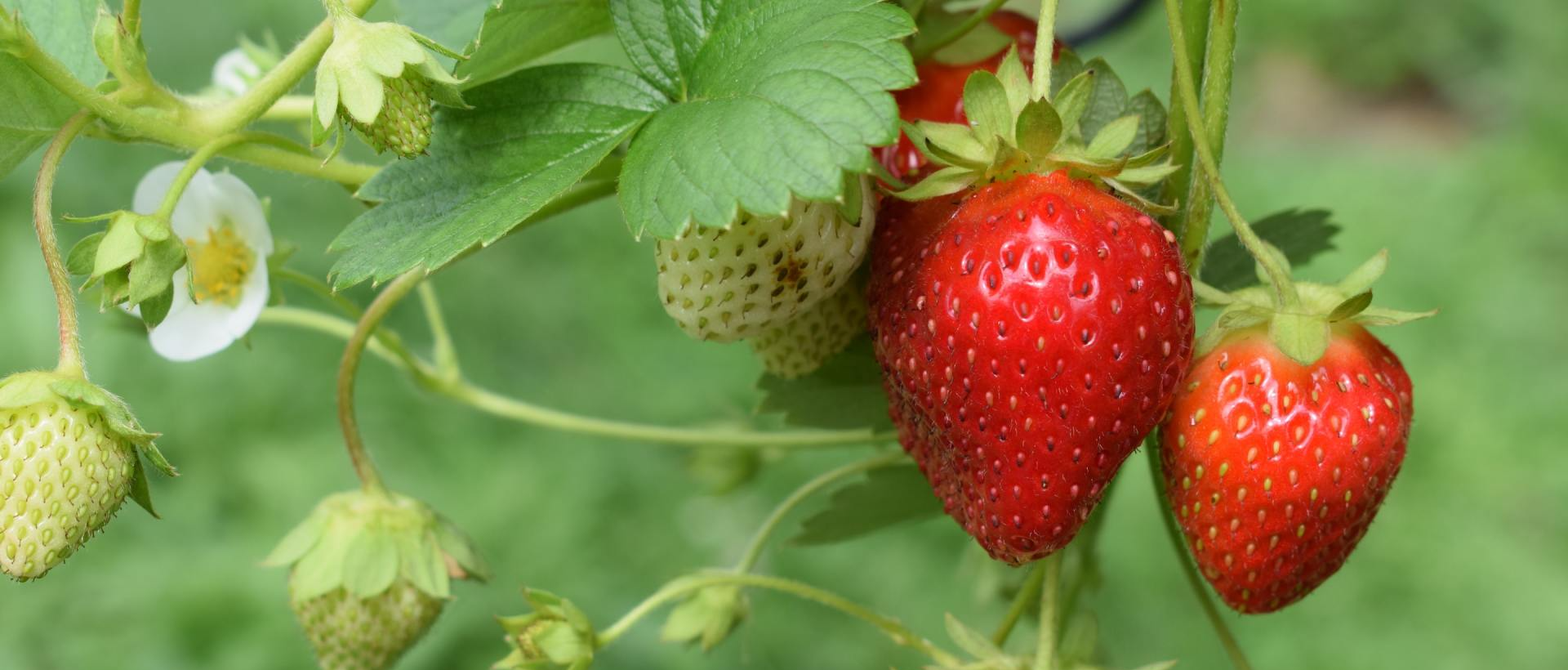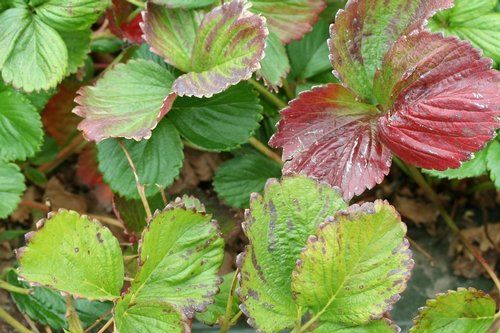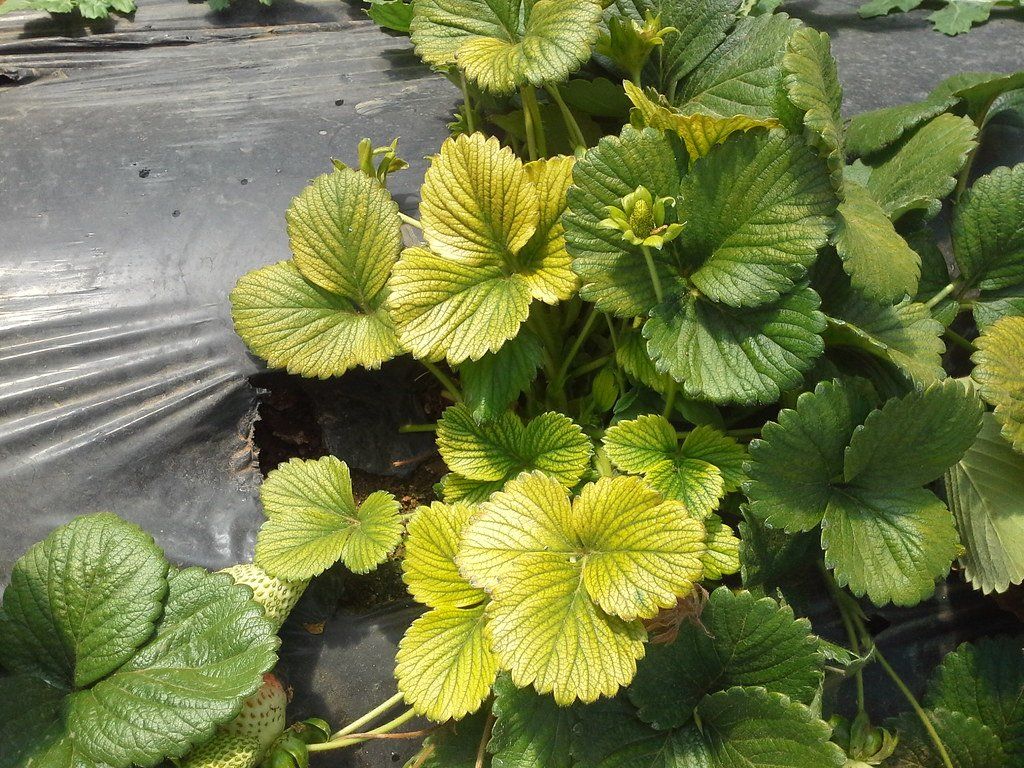Strawberries - Plant Nutrition Notes
Grow Great Strawberries.

Strawberries are one of the most sensitive plants in horticultural production. A good fertility program must be used because strawberries are very susceptible to nutrient problems. Close attention to the nutrient needs of your strawberries is vital because strawberries are harvested for an extended period during the season. They require a constant source of complete nutrition in just the right amounts to ensure good yields of high quality berries. The task is made even more difficult because straw-berries are also very susceptible to diseases and insect damage. However, developing a good fertility plan that is used in a timely manner will contribute to disease and insect control. Improving soil health is a key factor in insect and disease management as well as providing a foundation for building soil fertility.
Commercial strawberry production practices commonly include drip irrigation, which facilitates fertilization with soluble fertilizers injected into the watering system. Granular fertilizers are used for matted row and other production systems.
Soil and Tissue testing—why do it?
A soil test should be completed before planting berry plants. Results will provide information about the quantity of nutrients present and an estimate of how well those nutrients will be released for plant use. To get a more complete picture, tissue testing as plants grow and fruit appears, provides information about the intensity or rate of uptake into the plant. This will tell you whether the plants are getting the right amount of nutrition at the right time.
The plant integrates all the factors that affect nutrient uptake from the soil—chemical solubility, nutrient quantity, rainfall, sunlight, and temperature—and produces fruit according to how well (or poorly) the nutrient program meets the needs of the plant, under your growing conditions. Only tissue testing can tell you how well the plant is using the nutrients you’ve supplied, or whether more of certain nutrients are needed. Soil test results, coupled with periodic tissue testing provides a nutrient audit for a more complete picture of your crop’s health and vigor throughout the harvest season. The audit allows you to adjust the fertilization program as needed, during the growing season, to fix any problems that show up on tissue test results. The payoff is greater yield and higher quality fruit.
Strawberry trifoliate leaves
Strawberry tissue samples should consist of the most recently mature, trifoliate leaves and petioles. These leaves are fully expanded and consist of one petiole (leaf stem) with three leaflets. They are usually located 3 to 5 leaves back from the growing point. Avoid collecting leaves that are damaged or dull in color.
When the samples are being collected, it is very important to detach the petiole from the leaflets immediately and keep the petiole. It would be helpful to submit a few leaves for observation purposes. Petiole Analysis indicates the amount of nutrients that would be deficient or toxic in the next 7 to 21 days, and serves as a basis for the nitrogen, phosphorous, potassium and other macro and micronutrient rate recommendations.
Each sample should include 25 to 35 petioles randomly selected within a uniform representative area of the field. For example, all of the petioles in a single sample should be the same variety, growing on the same soil type, planted at the same time and having the same management history.
For the most accurate recommendations, TPSL asks growers to provide specific information about each sample. Details about fertilization history, soil test, environmental conditions and the name of the variety being grown should be written on the Plant Submittal Form, which is available on our website.
Soil pH
Strawberries prefer a soil pH of 6.0 to 6.5, in the slightly acid range. This is necessary to ensure uptake of adequate amount of several trace elements and phosphorus that are more plant available in that pH range. Adjustment of soil pH to this range is best done before planting. It takes some time to settle down the many chemical and biological changes that occur when soil pH is adjusted and plants can struggle with getting nutrients before the new conditions become effective. Agricultural lime, preferably dolomitic lime, can be used to increase pH if necessary, and ammonium sulfate, or elemental Sulfur can be used to reduce soil pH. These sources will also supply needed sulfur for proper plant nutrition. Sulfur needs have often been often overlooked in earlier fertilizer programs. Suggestions for soil pH adjustment will be included with your soil test results.
Nutrient Needs and Deficiencies
Nitrogen—a major nutrient involved in protein production in the plant is needed in large quantities. It should be supplied over the entire production period to ensure good yields and high quality. Depending on your soil type and whether you’re fertilizing established plantings or new plantings, Nitrogen needs range from 150 to 220 lbs. N/acre for new plantings and 75-120 lbs. N/acre for established plantings. Sandy soils will need about 20% more.
It’s best to divide up the total amounts needed into several smaller applications to ensure the plants have just the right amount of nutrient at just the right time. Too much is a waste, too little causes deficiency. Excellent berry production requires about 1 lb./acre per day in the harvest season.
Nitrogen deficiency can stunt growth. Leaves, especially the lower ones, will turn lighter green or even yellow, a condition called chlorosis. However, several nutrients can cause chlorosis, so a leaf tissue test should be done to determine the causes or causes, because more than one deficiency can result in chlorosis.
Nitrogen deficiency
Phosphorus—a major nutrient needed for DNA synthesis and energy production, root development, flower initiation and seed or fruit development. Strawberries need about 25-30 lbs./acre of Phosphorus. More may need to be applied because it may become tied-up in the soil.
Fertilizers are labeled with a three-part number, such as 10-20-20, which gives the bag contents of Nitrogen, Phosphorus, and Potassium. The Nitrogen number is just the percent of the element Nitrogen; the Phosphorus is listed as P2O5, the Potassium number is given as K2O. The P2O5 and K2O designations are holdovers from long ago when fertilizers were analyzed as those forms. It’s now become traditional to express them like that.
Phosphorus is very reactive in soils. If soil pH is outside the 5.5 to 7.3 range, Phosphorus tends to drop out of solution and become unavailable to plants. A slightly acidic pH keeps much of the phosphorus in a soluble form that’s available for plant uptake. This is why it is important to adjust soil pH before planting. Maintaining adequate levels of Phosphorus in the soil for extended plant production can be difficult. Tissue testing at critical times will determine whether sufficient phosphorus is being provided to the plants. Testing can tell if a problem exists before there are visual symptoms of deficiency, giving you a chance to remedy the shortage before too much harm has been done.
Potassium—a major nutrient important for fruit maturation and sugar transport into the fruit. Upwards from 150 lbs./acre is needed by a good crop, depending on the soil test results. Soil tests are good predictors of potassium availability because potassium does not form a true organic compound, nor does it precipitate easily in the soil. Much of the Potassium required is needed at flowering and fruit set, continuing on into fruit maturation. It is important to maintain high levels of Potassium at the mid- and later phases of strawberry production. Deficiency symptoms appear much like Phosphorus deficiency, but often cause additional leaf margin necrosis. Tissue testing is the best way to monitor the levels getting into the plant to avoid deficiencies.
Calcium and Magnesium—used by the plant for fruit firmness and storage quality. If soil tests indicate a need for these minor elements, they should be applied before plants are set out. These nutrients compete with each other for plant uptake, so it is important to make sure the correct ratio between the two is maintained throughout the season. In general, an 8:1 ratio is desired. If soil test Calcium levels are about 1000 parts per million (ppm), sufficient Calcium is present. If the soil has been limed earlier, Calcium should be sufficient. Dolomitic limestone contains Magnesium and can be used to maintain soil Magnesium concentrations around 150 ppm. Calcium and Magnesium are cat-ions that compete for uptake with other fertilizer cat-ions, such as ammonium and Potassium. For this reason, it is important to balance the total plant nutrition, taking into account competing characteristics of all fertilizer elements.
Trace Elements
Some nutrients are necessary but are used in very small amounts. These are the trace elements. Iron, Zinc, Manganese, Copper, Molybdenum and several others are necessary for healthy plants, being involved in various aspects of plant life, such as chlorophyll production and enzyme activities. The amounts needed are usually in the range of a few ounces per acre which works out to be about 20-45 ppm in leaf tissue. However, each element has its own optimal concentration range. Often foliar sprays are used to maintain sufficient levels in plant tissues, but soluble forms are available that can be applied by drip irrigation. Many fertilizers contain trace elements and, if the soil conditions are correct, these can be considered plant available. However, most trace elements are more soluble in acid soils and often become problematic in previously limed soils. This is another reason to complete soil pH adjustment treatments before planting.
Iron Deficiency
Boron is a trace element, so it is required in very small amounts. It is important for flowering, fruit set, and for the maturation of the strawberry fruit. What sets it apart from the other trace elements is that it is less available at lower soil pH. Liming generally increases the availability, but many alkaline soils respond to Boron because it is not present in sufficient amounts in the soil. Caution is advised when considering Boron fertilization because toxicity can occur by over-applying the nutrient. Several sources of soluble Boron, and the classical “borax” preparations are available to treat a deficiency with accurate amounts of the element.
The need for balancing nutrition for strawberries can be greatly facilitated by improving soil organic matter content. Not only does organic matter contain the major, minor and trace nutrient elements the plant needs, it also supports the growth of beneficial soil microbes that can help keep diseases in check and actually stimulate better strawberry growth and production. Making organic matter additions to the soil starts the process of turning over much of the nutrition and protection of plants to soil microbes, all to the benefit of the plants.






